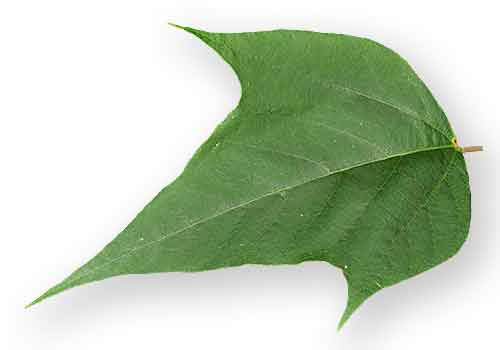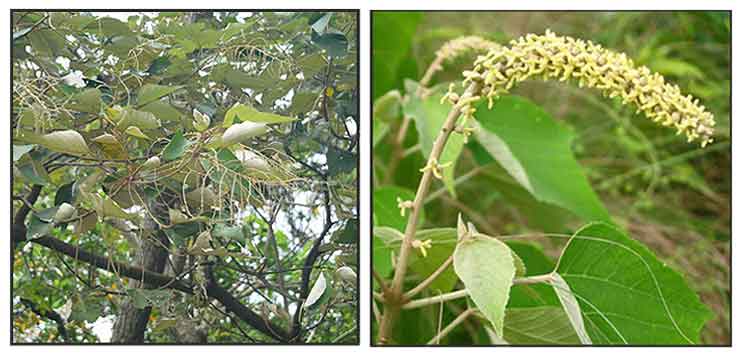
Family • Euphorbiaceae
Anaplan
Mallotus paniculatus (Lam.) Müll.Arg.
TURN-IN-THE-WIND / PANICLED MALLOTUS
Bai qui
| Scientific names | Common names |
| Croton paniculatus Lam. | Anaplan (Bukidnon) |
| Mallotus paniculatus (Lam.) Müll.Arg | Panicled mallotu (Engl.) |
| Rottlera paniculata (Lam.) A.Juss. | Turn-in-the-wind (Engl.) |
| Accepted infraspecifics (2) | |
| Mallotus paniculatus var. formosanus (Hayata) Hurus. | |
| Mallotus formosanus Hayata | |
| Mallotus paniculatus var.paniculatus | |
| Croton appendiculatus Elmer | |
| Echinus trisulcus Lour. | |
| Lasipana tricuspis Raf. | |
| Mallotus albus (Roxb. ex Jack) Müll.Arg. | |
| Mallotus chinensis Lour. | |
| Mallotus cochinchinensis Lour. | |
| Mappa cochinchinensis Spreng. | |
| Ricinus chinensis Thunb. | |
| Rottlera alba Roxb. ex Jack | |
| Rottlera cochinchinensis (Lour.) K.Koch | |
| Rottlera mappoides Dalzell | |
| Rottlera peltata Wight | |
| Trevia discolor Sm. | |
| Trevia tricuspidata Willd. | |
| Mallotus paniculatus is an accepted species. KEW: Plants of the World Online | |
| Other vernacular names |
| CHINA: Bai qui. |
| INDONESIA: Calik angin (Sundanese); Tutup awu, Tutu kancil (Javanese). |
| LAOS: 'khi thao, Lat koua, Lut ma. |
| MALAYSIA: Balek angin (Peninsular); Mallotus balabakan (Sabah). |
| THAILAND: Saet (Peninsular); Sate-ton, Soi daao. |
| VIETNAM: B[uj]c b[aj]c, Ba b[es]t nam b[ooj], Bai b[as]i. |
Distribution Constituents Properties
- Studies have suggested antibacterial, antioxidant, anticancer properties. Parts used Leaves, roots. Uses  Edibility Edibility- No study found on edibility. Folkloric - No reported folkloric medicinal use in the Philippines. - In Bangladesh, one of 23 plant species used for treatment of malaria. - In Malaysia, plant decoction used for cleaning wounds. Poultice of plant mixed with other plants used for treatment of headache. Lotion externally applied in children for fever. Root are boiled and drunk after childbirth. - In China, root decoction taken orally for treatment of leucorrhea. - In Indonesia, the Dayak people of Central Kalimantan use balik angin leaves for the treatment of acne by fine-grinding the leaves and applying it to the skin with acne. (8) Others - Crafts: Wood used for making matches, boxes, packaging, paper. - Fuel: Wood used as fuelwood. - Bark: Yield a fiber that can be used for making string or coarse cloth. Studies Availability |
May 2025
![]()
 |
| PHOTOS / ILLUSTRATIONS |
| IMAGE SOURCE: Mallotus paniculatus / 阿橋 HQ / CC BY-SA 2.0 Generic / Click on image or link to go to source page / Wikimedia Commons |
| OTHER IMAGE SOURCE: Mallotus paniculatus / Keisotyo / CC BY-SA 4.0 / Click on image or link to go to source page / Wikimedia Commons |
| IOTHER MAGE SOURCE: Euphorbiaceae : Mallotus paniculatus / Flowering twig / Copyright © 2011 by Leonardo L Co [ref. DOL33970] / Non-Commercial Use / Image modified / Click on image or link to go to source page / Phytoimages.siu.edu |
| IOTHER MAGE SOURCE: Euphorbiaceae : Mallotus paniculatus / Leaf / Copyright © 2017 b7 P B Pelser & J F Barcelona (contact: pieter.pelser@canterbury.ac.nz) [ref. DOL116511] / Non-Commercial Use / Image modified / Click on image or link to go to source page / Phytoimages.siu.edu |
Additional
Sources and Suggested Readings |
• |
DOI: It is not uncommon for links on studies/sources to change. Copying and pasting the information on the search window or using the DOI (if available) will often redirect to the new link page. (Citing and Using a (DOI) Digital Object Identifier) |
| List of Understudied Philippine Medicinal Plants |
| New plant names needed The compilation now numbers over 1,500 medicinal plants. While I believe there are hundreds more that can be added to the collection, they are becoming more difficult to find. If you have a plant to suggest for inclusion, native or introduced, please email the info: scientific name (most helpful), local plant name (if known), any known folkloric medicinal use, and, if possible, a photo. Your help will be greatly appreciated. |
• |
 |



